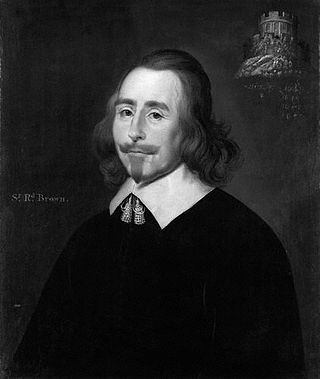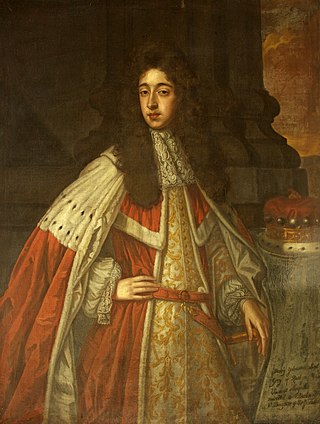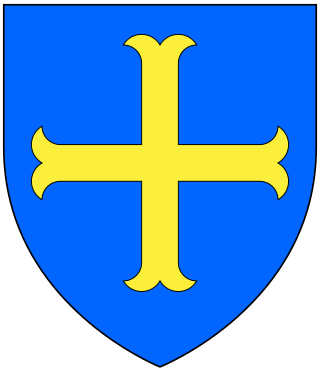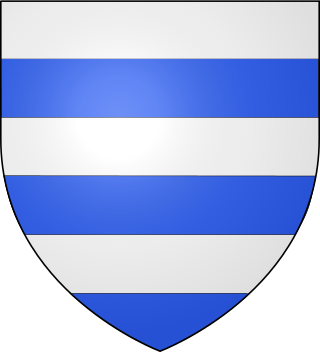
Christopher Hatton, 1st Viscount Hatton (1632–1706) was an English aristocrat and diplomat.

Viscount Cobham is a title in the Peerage of Great Britain that was created in 1718. Owing to its special remainder, the title has passed through several families. Since 1889, it has been held by members of the Lyttelton family.

Baron Hastings is a title that has been created three times. The first creation was in the Peerage of England in 1290, and is extant. The second creation was in the Peerage of England in 1299, and became extinct on the death of the first holder in c. 1314. The third creation was in the Peerage of England in 1461, and has been in abeyance since 1960.

Marquess of Hastings was a title in the Peerage of the United Kingdom. It was created on 6 December 1816 for Francis Rawdon-Hastings, 2nd Earl of Moira.

Baron Grey of Ruthin was a noble title created in the Peerage of England by writ of summons in 1324 for Sir Roger de Grey, a son of John, 2nd Baron Grey of Wilton, and has been in abeyance since 1963. Historically, this branch of the Grey family was seated at Ruthin Castle in Wales.

Earl of Sussex is a title that has been created several times in the Peerages of England, Great Britain, and the United Kingdom. The early Earls of Arundel were often also called Earls of Sussex.

There have been three baronetcies created for persons with the surname Booth, one in the Baronetage of England and two in the Baronetage of the United Kingdom. The 1916 creation remains extant, the 1835 creation became extinct in 1896 and the 1611 baronetcy has been dormant since 1797. The senior line of the first creation was elevated to the peerage as Baron Delamer and Earl of Warrington.
Henry Yelverton may refer to:

There have been ten baronetcies created for persons with the surname Browne, six in the Baronetage of Great Britain, three in the Baronetage of Ireland and one in the Baronetage of Nova Scotia. Only one creation is extant as of 2010. Three of the creations were for members of the Browne family headed by the Viscount Montagu.

There have been three baronetcies created for members of the Grey family, one in the Baronetage of England, one in the Baronetage of Great Britain and one in the Baronetage of the United Kingdom. Two of the creations are extant as of 2007.

Viscount Longueville was a title created twice, once in the Peerage of England and once in the Peerage of Ireland. On 21 April 1690, Henry Yelverton, 15th Baron Grey de Ruthyn was created Viscount Longueville in the Peerage of England. His son the second viscount, Talbot Yelverton, was created Earl of Sussex in 1717, with which title the viscountcy then merged, until both titles became extinct in 1799 on the death of the third Earl.

There have been two baronetcies created for persons with the surname Goring, both in the Baronetage of England. The second creation came into the family through a special remainder in the patent creating the baronetcy. Only the latter creation is extant as of 2008.

There have been four baronetcies created for members of the ancient House of Beaumont, all in the Baronetage of England. All four creations are extinct or dormant.

There have been three baronetcies created for descendants of the ancient Norman family of Molyneux who were granted extensive estates in Lancashire after the Norman Conquest.

There have been five baronetcies created for members of the old established family of Peyton of Peyton Hall in the parish of Boxford in Suffolk, all of whom were descended from Sir Robert Peyton of Isleham in Cambridgeshire, grandson and heir of Thomas Peyton (1418–1484) of Isleham, twice Sheriff of Cambridgeshire and Huntingdonshire, in 1443 and 1453. All the baronetcies are extinct.
There have been two baronetcies created in the Baronetage of England for members of the Colepeper family of Kent and Sussex. Both are extinct.
Talbot Yelverton, 1st Earl of Sussex was an English peer and member of the House of Lords, styled Hon. Talbot Yelverton until 1704, and known as Talbot Yelverton, 2nd Viscount Longueville from 1704 to 1717, when he was created Earl of Sussex.
Sir Henry Yelverton, 2nd Baronet was an English politician who sat in the House of Commons in 1660 and from 1664 to 1670.

The Grey family is an ancient English noble family from Creully in Normandy. The founder of the family was Anchetil de Greye, a Norman chevalier and vassal of William FitzOsbern, 1st Earl of Hereford, one of the few proven companions of William the Conqueror known to have fought at the Battle of Hastings in 1066.















